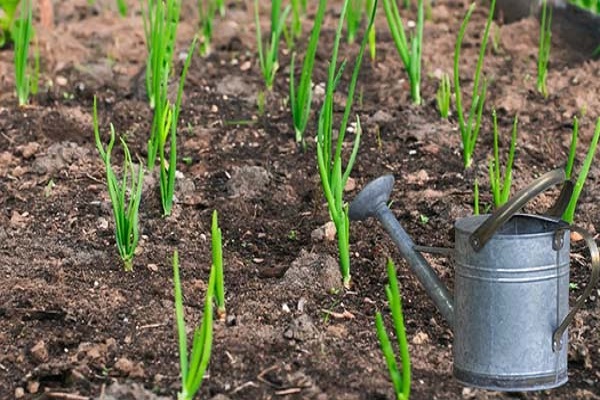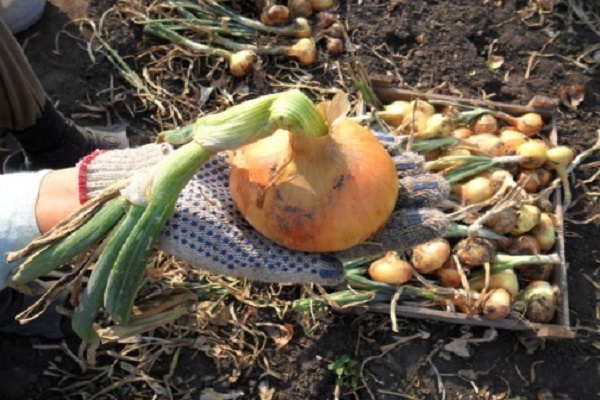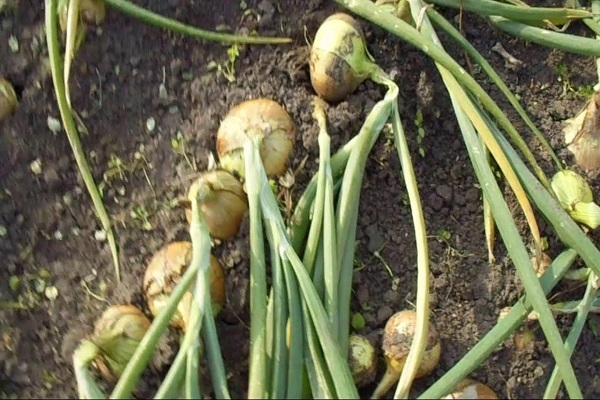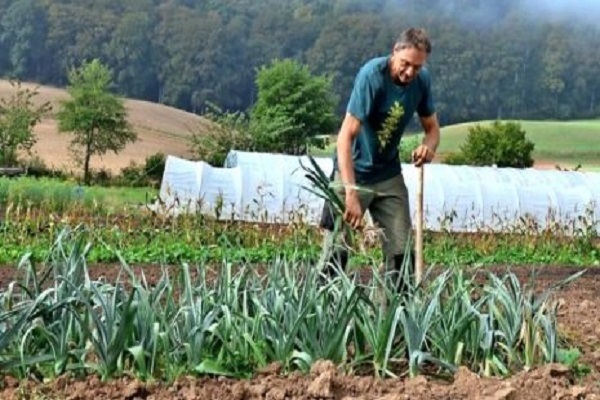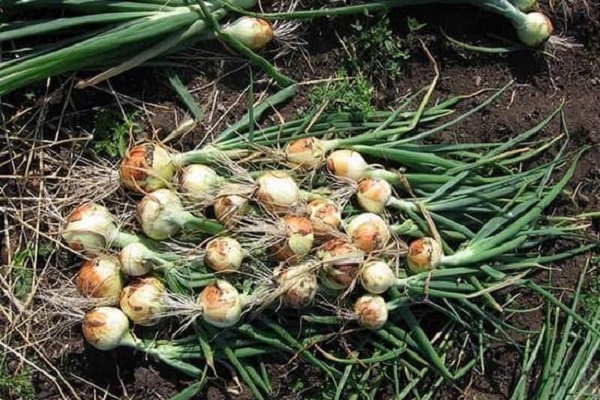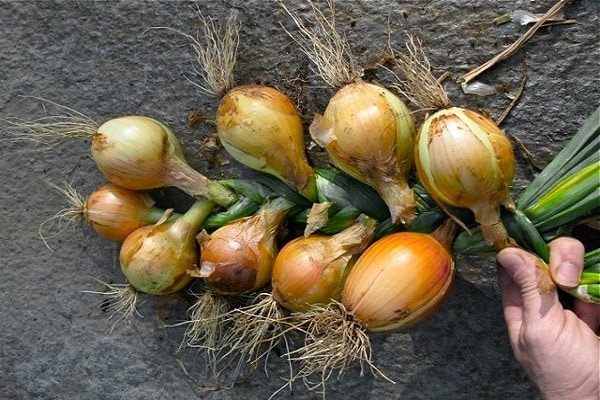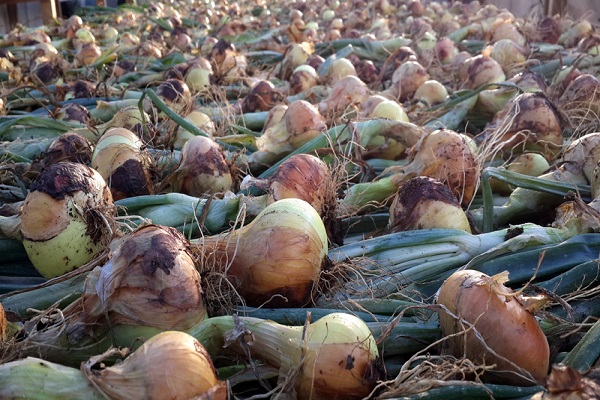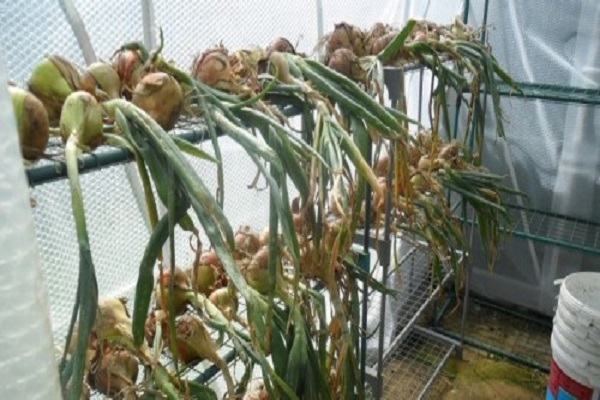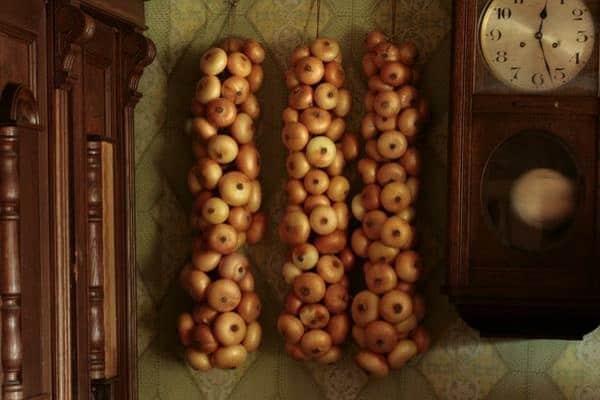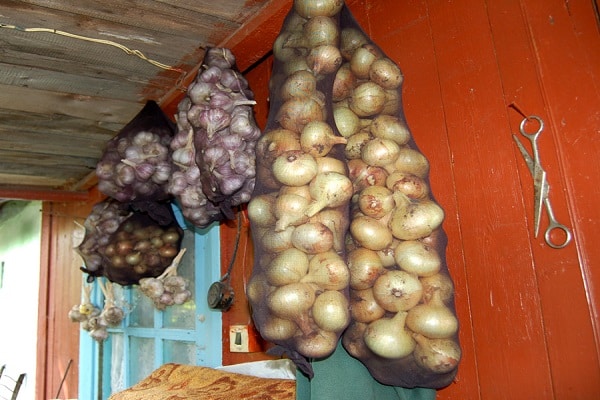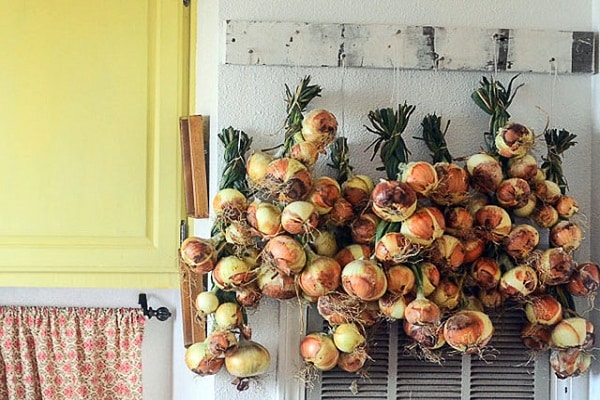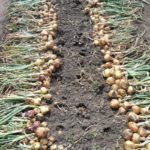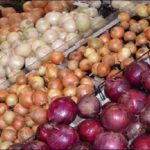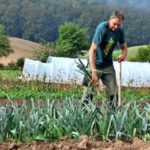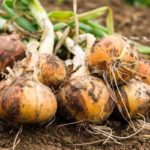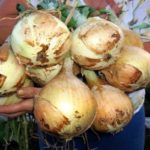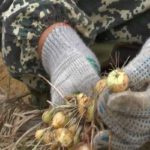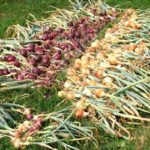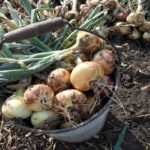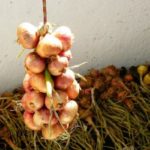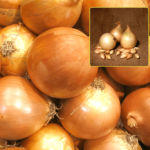Having grown a rich harvest, any summer resident will wonder when to harvest ripe onions? Some of them use the gardener's lunar calendar to determine the optimal harvest time. If it is not at hand, the summer resident should know when to harvest the bulbs in different parts of the country, how to process it after harvesting, dry it and store it.
When to stop watering onions?
When signs of onion maturity appear, stop watering it. Most often this happens 2-3 weeks before the expected cleaning date.It is worth considering that the intake of moisture provokes active ripening of the bulb and the growth of additional roots, which negatively affects the keeping quality of the crop. Therefore, in order for the bulbs to store well in winter, they should be stopped watering as soon as the heads are fully formed. With such manipulations, the head ripens more slowly, and the onion will be less susceptible to rotting.
When to remove onions from the garden?
Onions should be removed from the garden in dry weather. You can determine the readiness of the bulbs for harvesting by the characteristics of its maturation: the neck of the head begins to dry out and the feathers turn yellow. At the same time, the bulbous heads begin to color the top layer of their scales in a color characteristic of the variety. Generally, harvesting begins at the end of July and continues until the beginning of September. Signs of maturity:
- If the vegetable was planted before winter, it is necessary to harvest the crop from the garden before the varieties planted in the spring.
- When bulbs are grown in central Russia, in the Moscow region, the vegetable must be harvested in the last days of July. If the summer was hot, cleaning begins on the 20th of July.
- Timing for harvesting ripe onions in Siberia, in the Urals, in the northwestern part of Russia will be different. In these regions, it is recommended to harvest in August or early September.
To accurately determine the optimal onion harvest time, it is necessary to pay attention to its vegetation. From the moment of spring planting and the formation of seedlings, this period is 70–85 days. To determine the best time to harvest a vegetable, you just need to count the specified number of days.
How to dig correctly?
After the summer resident has learned when to dig up onions, he should understand how to do it correctly. Harvesting should only be done in clear weather, and the onion should not be pulled out of the ground.It is better to start digging up the crop with a shovel, having dug up the planting.
The recommended time of day to collect onions has also been determined empirically. It is best to do this in the morning and then leave the crop in the sun until the evening. Periodically it needs to be shaken and turned over.
Harvesting in the rain
Like other plants, it is not recommended to dig up onions in cloudy weather. But if good weather is not expected in the near future, and the onion crop needs to be harvested urgently, harvesting is allowed even in the rain. Vegetables are pulled out of the ground using a small spatula.
In order for the bulb to dry, it needs to be dried in a dry room for 2-3 weeks. In this case, after digging the turnip, it is necessary to cut off the tops and roots. Next, the head is completely cleared of husks. During drying, a new husk will form on the bulb, which will significantly extend the shelf life of the crop.
Onion trimming
To protect the harvest from pests and diseases, onions need to be trimmed. The bulbs are trimmed before the vegetables dry out. Most often, this process takes an average of 2 weeks.
After the onion is dug up, its roots and feathers should be trimmed after drying under a canopy. This is a necessary condition for long-term storage of onions.
To store the resulting harvest in boxes during the winter, you will need to completely cut off the roots and leave a tail of 5 centimeters from the feathers. If the crop will be stored in baskets, boxes or nets, its feathers should be trimmed, leaving a tail of 7-10 centimeters, and roots - 1-2 centimeters.
If you plan to store the vegetable in braids, the feathers should be trimmed so that a stalk of 10–15 centimeters remains.The bulbs are intertwined in pairs and then wrapped with twine. This crop is stored hanging.
How to dry onions correctly?
Drying the harvested crop is a necessary condition, during which all pathogenic microorganisms are destroyed on the surface of the vegetable. There are several types of drying, each of which depends on the weather.
Many summer residents dry onions directly in the garden, leaving them there for 1–2 weeks. The complexity of this method lies in the fact that the left crop must be turned regularly to prevent rotting.
Since the vegetable should be dried under conditions of good ventilation, the best option is to place it in the fresh air under a canopy. The good thing about using drying under a canopy is that the vegetable is not exposed to any precipitation, and optimal humidity is established outside (provided that drying is carried out in good weather).
If the weather outside is cloudy or rainy, the vegetable should be dried in a well-ventilated area with low humidity. In order for the onion to have good shelf life, it should be stirred regularly. To avoid this, you can dry the bulbs in nylon tights, hanging them in a dry, dark room. If the onion grows in conditions of high humidity, all the husks should be removed from it before drying, while leaving the neck of the onion.
Onions can also be dried in armored nets, which provide excellent ventilation to the vegetable. This method is good because the crop does not require regular tedding.
To determine when onions are dry, stack them in a pile and stick your hand into it. If the hand passes freely, then the harvest is ready for storage, and if there are difficulties, the bulbs still need to be dried.
How to store onions at home?
Only ripe vegetables can be stored, so the bulbs should be sorted. It is recommended to consume and not store those heads that have fragile scales and a thick neck, as these vegetables will spoil faster. Also, vegetables that are over-seasoned in the garden do not have a long shelf life. Such bulbs sprout and lose their scales.
After the summer resident has selected the bulbs suitable for storage, it is necessary to decide on the place for their storage. To preserve all the beneficial properties of the vegetable, as well as its suitability for consumption, the storage space must be well ventilated and the container must be breathable. Experienced summer residents consider the best places for storing onions in the apartment mezzanines, drawers in the closet, pantries. The harvest should be stored in wicker baskets, wooden boxes, cardboard boxes, stockings, bags made of fabric or paper, and tied into braids. Tara:
- Wicker baskets allow air to pass through well. Also, their small size helps avoid the appearance of rot. Using baskets is inconvenient only because a small amount of crop can be placed in them, and there is no possibility of stacking containers on top of each other.
- Wooden storage boxes must be shallow. They should fit an onion layer no more than 30 centimeters thick. The advantage of using such storage products is that the boxes can be stacked on top of each other to save space.
- Another way to store crops is cardboard boxes. To prevent the onions from rotting in them, they should be poured in a 25–30 cm layer. It is also necessary to make holes on the bottom and walls of the box to provide additional ventilation.
- Stockings or old nylon tights are an excellent material for storing the harvest. They allow air to pass through well, preventing the formation of rot. Also, such items can be stored in a hidden state without taking up the right place in the apartment.
- Braids. One of the best ways to store onions at home is to form the harvest into braids. They can be stored in the pantry, and if desired, such an item can become a real decoration of the kitchen. They should be hung in places protected from sunlight, with good ventilation and low humidity.
When using boxes or bags, do not pour the entire crop into them. The onion will be stored well if its layer does not exceed 30 centimeters. To extend the shelf life of the crop, it can be sprinkled with onion peels or chalk. To process 10 kilograms of heads you will need 200 grams of chalk. This component will protect the crop from moisture accumulation and rot.
During the winter, all onions that are stored at home need to be sorted out twice or thrice. This procedure is mandatory, since damaged or not fully ripened bulbs could begin to rot. If the crop is not sorted, the rotting heads will infect healthy ones, which is why all vegetables may lose their nutritional value.
Experienced summer residents also sort through the harvest in order to assess whether all the heads are completely dry and whether moisture is accumulating in them. Damp bulbs need to be dried again. You can dry such onions directly in the oven, placing them on a baking sheet, preheating the oven to the minimum temperature. Then the device is turned off, its door is opened, and the bulbs are dried until the device cools completely.
In order for onions to be stored for a long time, they must be placed not only in optimal conditions, but also grown correctly, removed from the garden in a timely manner, dried, and trimmed with roots and feathers. Such processing of the crop will allow it to be preserved throughout the winter, while the nutritional qualities and benefits of the vegetable are preserved in full. Also, before planting onions for further storage, you need to choose a variety suitable for this.

